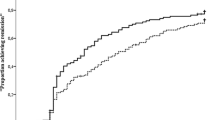Abstract
To compare the effectiveness of retreatment of rheumatoid arthritis (RA) patients with rituximab (RTX) following the treat-to-target retreatment (TTr) or fixed interval retreatment (FIr) strategy. RA patients starting RTX treatment between January 2008 and June 2016, and receiving at least three infusion cycles were grouped by strategy (TTr, FIr or both). Primary outcome (between strategy difference in DAS28-CRP (Disease Activity Score in 28 joints calculated with C-reactive protein)) and secondary outcomes (flares, use of co-medication and mean yearly dose of RTX) were analyzed by group using linear mixed models to account for different strategies within patients. A total of 213 patients, 59 TTr (of whom 32 switched from TTr to FIr) and 186 FIr were included. No between-group difference in mean DAS28-CRP was found (0.10 DAS28-CRP point (95% CI − 0.07 to 0.26)). The TTr strategy did not result in more flares (IRR 1.13, 95%CI 0.87 to 1.47), conventional synthetic disease-modifying antirheumatic drug use (difference − 11.7%, 95%CI − 26.3% to 2.9%), or lower mean yearly RTX dose (difference 172 mg/yr, 95%CI − 355 to 11.7 mg/yr). RTX retreatment with either a TTr or FIr strategy does not seem to lead to better disease control and/or less drug use when used in a DAS28-CRP treat-to-target context. Choice of either strategy can, therefore, be made based on patient and physician preferences and logistical context.
Similar content being viewed by others
Data availability
The datasets generated and analyzed during the study are not publicly available but are available from the corresponding author upon reasonable request.
References
Emery P, Fleischmann RDANCER, Group Study, et al. et al (2006) The efficacy and safety of rituximab in patients with active rheumatoid arthritis despite methotrexate treatment: results of a phase IIB randomized double-blind, placebo-controlled, dose-ranging trial. Arthritis Rheum. 54:1390–1400. https://doi.org/10.1002/art.21778
Cohen MD, Keystone E (2015) Rituximab for Rheumatoid Arthritis. Rheumatol Ther 2:99–111. https://doi.org/10.1007/s40744-015-0016-9
Edwards JC, Szczepanski L et al (2004) Efficacy of B-cell targeted therapy with rituximab in patients with rheumatoid arthritis. N Engl J Med. 04(350):2572–2581. https://doi.org/10.1056/NEJMoa032534
van der Togt CJT, Van den Bemt B et al (2023) Points to consider for cost-effective use of biological and targeted synthetic DMARDs in inflammatory rheumatic diseases: results from an umbrella review and international Delphi study. RMD Open 9(1):e002898. https://doi.org/10.1136/rmdopen-2022-002898
Tavakolpour S, Alesaeidi S et al (2019) A comprehensive review of rituximab therapy in rheumatoid arthritis patients. Clin Rheumatol 38(11):2977–2994. https://doi.org/10.1007/s10067-019-04699-8
Emery P, Mease PJ et al (2011) Retreatment with rituximab based on a treatment-to-target approach provides better disease control than treatment as needed in patients with rheumatoid arthritis: a retrospective pooled analysis. Rheumatology (Oxford) 50:2223–32. https://doi.org/10.1093/rheumatology/ker253
Chatzidionysiou K, Lie E et al (2017) Rituximab Retreatment in Rheumatoid Arthritis in a Real-life Cohort: Data from the CERERRA Collaboration. J Rheumatol. 44:162–169. https://doi.org/10.3899/jrheum.160460
Van der Maas A, Lie E et al (2013) Construct and criterion validity of several proposed DAS28-based rheumatoid arthritis flare criteria: an OMERACT cohort validation study. Ann Rheum Dis 72:1800–5. https://doi.org/10.1136/annrheumdis-2012-202281
Pope JE, Haraoui B et al (2014) The Canadian methotrexate and etanercept outcome study: a randomised trial of discontinuing versus continuing methotrexate after 6 months of etanercept and methotrexate therapy in rheumatoid arthritis. Ann Rheum Dis. 73:2144–2151. https://doi.org/10.1136/annrheumdis-2013-203684
Porter D, van Melckebeke MJ et al (2016) Tumour necrosis factor inhibition versus rituximab for patients with rheumatoid arthritis who require biological treatment (ORBIT): an open-label, randomised controlled, non-inferiority, trial. Lancet 388:239–247. https://doi.org/10.1016/S0140-6736(16)00380-9
Bredemeier M, Campos G, de Oliveira K et al (2015) Updates systematic review and meta-analysis of randomized controlled trials comparing low- versus high-dose rituximab for rheumatoid arthritis. Clin Rheumatol. 34:1801–1805. https://doi.org/10.1007/s10067-015-2977-z
Smolen JS, Landewé RBM et al (2023) EULAR recommendations for the management of rheumatoid arthritis with synthetic and biological disease-modifying antirheumatic drugs: 2022 update. Ann Rheum Dis 82:3–18. https://doi.org/10.1136/ard-2022-223356
Funding
No specific funding or sponsorship was received for this study or the publication of this article.
Author information
Authors and Affiliations
Contributions
All authors take full responsibility for the integrity and accuracy of all aspects of the work.
Corresponding author
Ethics declarations
Conflict of interest
Alfons A den Broeder received research grants to the institution from Abbvie, Pfizer, Lilly, Gilead, Novartis, Galapagos and Cellgene. Lisa Schapink, Nathan den Broeder, and Lise M Verhoef declare that they have no conflict of interest.
Additional information
Publisher's Note
Springer Nature remains neutral with regard to jurisdictional claims in published maps and institutional affiliations.
Rights and permissions
Springer Nature or its licensor (e.g. a society or other partner) holds exclusive rights to this article under a publishing agreement with the author(s) or other rightsholder(s); author self-archiving of the accepted manuscript version of this article is solely governed by the terms of such publishing agreement and applicable law.
About this article
Cite this article
Schapink, L., den Broeder, N., den Broeder, A.A. et al. Treat-to-target vs fixed interval retreatment strategy with rituximab in rheumatoid arthritis: a retrospective cohort study. Rheumatol Int (2024). https://doi.org/10.1007/s00296-023-05524-x
Received:
Accepted:
Published:
DOI: https://doi.org/10.1007/s00296-023-05524-x




